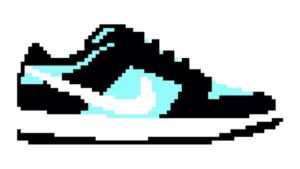The conquest of the metaverse by the fashion industry
More and more trademark owners are expanding their registration applications to include goods that can be virtually downloaded, thereby securing their rights and presence in the metaverse. This is not surprising, as the virtual reality sector is growing rapidly.
The metaverse is a digital universe project in which decisions made by users affect the real world. Thanks to virtual avatars we will soon be able to communicate, buy products and services and even work in virtual reality. According to research agency Strategy Analytics, the global metaverse could be worth $280 billion by 2025. Such a market forecast certainly increases the interest of companies in this idea.
Nike Inc. recently filed a package of new trademark applications in the U.S. for some of its best-known marks (including NIKE, Just Do It, and the AIR JORDAN logo) covering various goods and services in Classes 9 and 42, including virtual goods for download in Class 9 and retail store services with virtual goods in Class 42.
A trademark application for the same classes has also been filed with the European Union. The sports giant’s plans for these new trademarks are still unclear, but they clearly announce its willingness to expand its influence in the virtual reality market. Nike is a pioneer among well-known brands in terms of entering the metaverse – it first partnered with gaming platform Roblox back in 2019. That’s where an interactive space called Nikeland was created.
But Nike isn’t the only apparel company interested in conquering virtual reality. Last December, Ralph Lauren filed a trademark application with the U.S. Patent and Trademark Office covering store services with virtual clothing and accessories for use in online virtual worlds (35) and virtual clothing and accessories for use in online virtual environments that cannot be downloaded (41). Also, Bobbi Brown filed an application for registration for the use of its name in connection with Class 9 (which specifically concerned NFTs – non-transferable tokens) and Class 42 (which covers, „virtual online goods that cannot be downloaded” and, „NFTs or other digital tokens based on blockchain technology”). Also, Clinique, a cosmetics and skincare brand, has filed applications in Classes 9 and 42.
All of the above applications were filed by the brands themselves. However, there is also no shortage of situations where applications for the names of well-known brands are filed by unrelated persons. This appears to be an attempt to register in bad faith. For example, in November, third parties filed two applications in the United States to register the word marks of Prada and Gucci for several metaverse-related categories, including virtual downloadable goods, virtual worlds, and virtual apparel worn in virtual spaces. On metaverse platforms with user-generated content, such as the aforementioned Roblox, creators are now selling clothing with logos from brands such as Louis Vuitton, Prada, and Chanel.
The NFT market is still developing and brands are just entering it. So we don’t know their exact plans or how they will use the designations they register. We will certainly be following the virtual reality fashion industry as it develops. Given its pace, it may not be long before our online avatars are wearing more expensive shoes than us!
See more:
SUMMER IP MEETINGS FOR LAW STUDENTS IN OUR GARDEN
Discover the Fascinating World of Intellectual Property Rights with Żuraw i Wspólnicy sp. k.! Are you a law student interested in intellectual property law? Do you want to learn about trademarks and their protection principles? Are you eager to explore...
CJEU Ruling Reinforces: Mere Knowledge of Existing Trade Marks Isn’t Enough to Prove Bad Faith Applications
In its judgment of 15 May 2024, in Case T-181/23, the CJEU dismissed the appeal against the decision of the EUIPO Board of Appeal and thus, the Court once again confirmed that the applicant’s mere knowledge of a third party's earlier trade mark shall not be sufficient...
A Czech court rules on copyright to a work generated by AI
Artificial intelligence is becoming more and more prominent in the sector of music, literature and, as a matter of fact, in most fields that require a creative approach to any task or issue so far reserved exclusively for humans. It was therefore only a matter of time...


